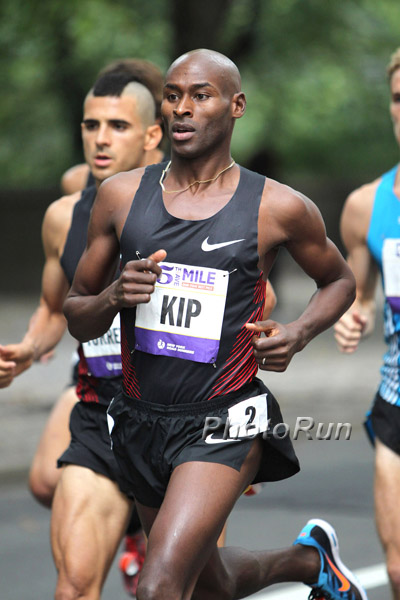
By ELLIOTT DENMAN
NEW YORK – Bernard Lagat will be more than halfway to his 38th birthday by the time of the London Olympic Games.
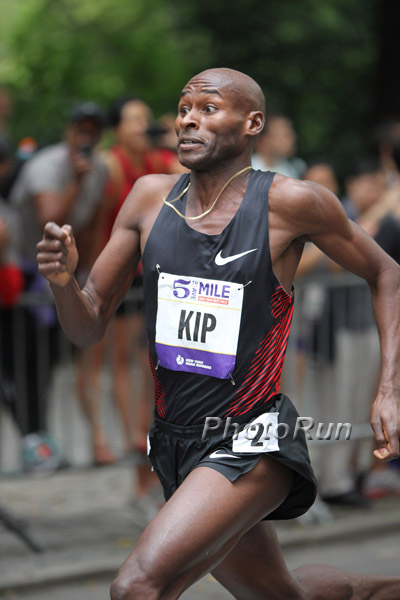 Bernard Lagat, 2011 Fifth Avenue Mile, photo by PhotoRun.net
Bernard Lagat, 2011 Fifth Avenue Mile, photo by PhotoRun.net
He’s already been to three Olympics – running off with the bronze
medal in the 1500 meters at Sydney in 2000 and the silver at Athens in
2004 (for Kenya), then joining Team USA to place ninth in the 5000 after
bowing out in the semifinals of the 1500 at Beijing in 2008.
A fourth Olympic appearance – and perhaps a third medal – surely seems to be in the cards .
After all, the Washington State University grad who now lives and
trains in Tucson, Arizona showed no signs of decline in 2011.
The opposite, in fact.
It was one heck of a year for him.
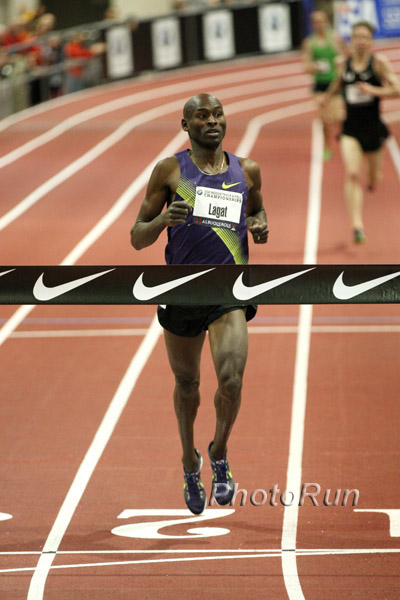 Bernard Lagat, 2011 USA Indoor Champs, photo by PhotoRun.net
Bernard Lagat, 2011 USA Indoor Champs, photo by PhotoRun.net
Consider: He lowered the American indoor 2-mile record to 8:10.07.
He took the USA indoor 3000-meter title in 7:57.17. He claimed the USA
outdoor 5,000-meter title (in a strategic 13:23.06.) He lowered the
American outdoor 5,000-meter record 12:53.60. He battled Great
Britain’s Mo Farah down to the wire in the World Championship 5,000
final before settling for second just 28/100ths of a second back.
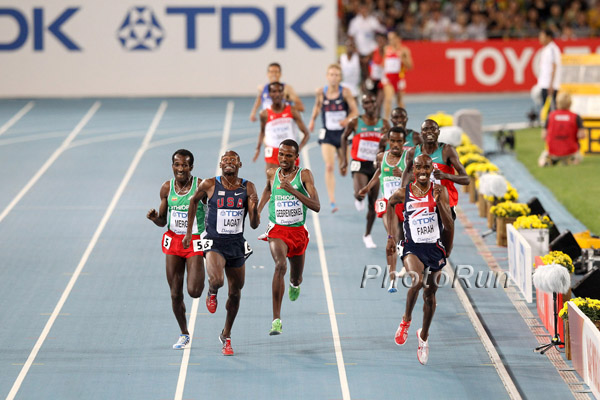 Lagat, Farah, 2011 WC 5,000m, photo by PhotoRun.net
Lagat, Farah, 2011 WC 5,000m, photo by PhotoRun.net And
he capped it all by taking his first Fifth Avenue Mile title in New York
(in his fourth try) with a decisive 3:50.5 verdict over Morocco’s
defending champion, Amine Laalou.
So what now?
In an unforgiving sport that has seen countless middle distance
greats slump to the wayside as they moved from mid to late 30s – perfect
examples John Walker, Mike Boit, Wilson Waigwa, Steve Scott, Said
Aouita and more – it would be tempting to suggest that Lagat seems
destined for an inevitable decline of his own.
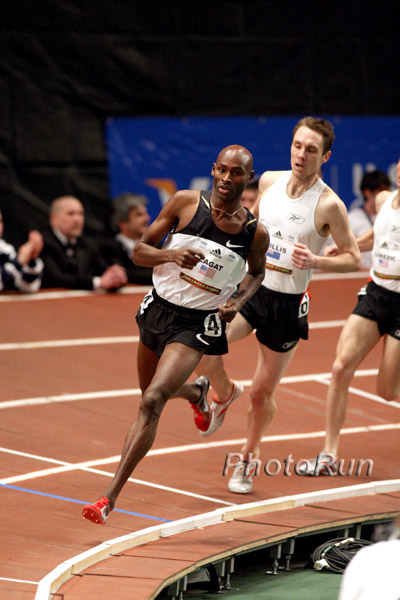 Bernard Lagat, Nick Willis, 2009 Millrose Games, photo by PhotoRun.net
Bernard Lagat, Nick Willis, 2009 Millrose Games, photo by PhotoRun.net
That script seemed to begin at last winter’s Millrose Games, which
just happened to be the last Millrose Games to be held at Madison Square
Garden. In a dramatic Wanamaker Mile that boiled down to a
desperation, around-the-22nd-and-last-turn duel with Ethiopia’s Deresse
Mekonnen, it was the 23-year-old Mekonnen who had the big lift and not
the 36.2-year-old Lagat, winning it 3:58.58 to 3:59.01.
Some called it an omen, suggesting that the huge final rush that had
been Lagat’s trademark move all along, had finally deserted him, and
that anytime down the line Lagat faced up to a bright, younger man, it
would be that younger man who’d prevail.
Well, that was proven wrong-wrong-wrong.
Fast forward seven months to the IAAF World Championships at Daegu.
As Lagat was again proving his agelessness by taking Farah down to the
final strides of the 5,000-meter final that was one of the classics of
the whole 9-day World Championship meet, it was Mekonnen fading to the
sidelines.
At 23, the Ethiopian proved he still had much to learn about world-class running,
bowing out with little notice, a clearly outrun 11th-place finisher in
his semifinal of the 1,500 meters. In fact, his 3:44.65 performance
would have left him far arear of his own Millrose pace, and that on the
allegedly-slow Garden track, too.
So, as ever, it simply boiled down to the timing.
Whatever he achieves from here on out, Lagat will be recognized for his impeccable timing.
In the second decade of the 21st century, the Olympic and World
Championship races bear little resemblance to the highest-level, Diamond
League-caliber events at all distances from the 800 meters and 1500 and
1-mile to 3000 and 5000 meters, all the way up to the 10,000.
The Olympics and Worlds are invariably slow-paced,
violently-finishing events that require the closing speed of a
sprinter. But all the others are rabbited, even-paced, hot-tempo events
which produce almost all of the year’s speediest times.
To get to an Olympics or a Worlds (or for Americans the trials for
each of them) runners must first have posted qualifying times from the
hot-tempo meets before gaining the privilege of running the title/medal
meets.
That’s the fact of middle distance life Lagat has mastered as well as
anyone in the sport’s history. He’s still the second fastest-ever man
at 1500 meters with his 3:26.34 (for Kenya) back in 2001. At one mile,
he’s ninth all-time at 3:47.28 (again for Kenya in 2001.) So the speed
has been there for years and much of it is still there.
The 3:50.5 win on Fifth Avenue provided fresh evidence.
“This was my time,” he told reporters, “I never really stopped
training after Worlds. I wanted to be as ready (for this) as going into a
big meet in Europe.”
In the past, he’d treated his Fifth Avenue races as a post-season
cool-down, a virtual vacation jaunt before going – ever so briefly –
into relaxation mode.
But this one was no vacation. He went at it full blast – with winning results.
So now it’s back to Arizona and his patented training program under Coach James Li.
Expect him to emerge from winter hibernation in the Wanamaker Mile
at the Millrose Games (now at the Armory Track Center and its
world-renowned track on 168th Street
in Washington Heights) next February 11th,
And then, as ever, it will be one carefully-timed step after another
and another on the route to the USA Olympic Trials at Hayward Field and
then London.
Sure, he’ll be a virtual senior citizen running against the relative
kids of the sport, but that’s a role he relishes. The man who’s done it
all – most would agree – still has a few lessons to teach the younger
generation.
Post-London, don’t count on him fading away, either.
Plenty of goals will remain.
One, for sure, would be attacking the sub-4 mile as a 40-plus, and
joining Eamonn Coghlan as the lone 40 ever to beat 4 – perhaps
challenging Coghlan’s Masters indoor record (3:58.15 in 1984) and maybe
even running a sub-4 outdoors, a Masters feat not yet achieved.
(Russia’s Vyascheslav Shaburin, at 4:01.62 in 2010, is the world outdoor
Masters mile record-owner.)
Coghlan, always an admirer of Lagat, would surely be the first to
approve of these challenges. And Lagat’s career-long finish-line
heroics prove he’s always agreed with Coghlan’s famous strategic
philosophy – “one move and one move only.”

Author

Larry Eder has had a 52-year involvement in the sport of athletics. Larry has experienced the sport as an athlete, coach, magazine publisher, and now, journalist and blogger. His first article, on Don Bowden, America's first sub-4 minute miler, was published in RW in 1983. Larry has published several magazines on athletics, from American Athletics to the U.S. version of Spikes magazine. He currently manages the content and marketing development of the RunningNetwork, The Shoe Addicts, and RunBlogRun. Of RunBlogRun, his daily pilgrimage with the sport, Larry says: "I have to admit, I love traveling to far away meets, writing about the sport I love, and the athletes I respect, for my readers at runblogrun.com, the most of anything I have ever done, except, maybe running itself." Also does some updates for BBC Sports at key events, which he truly enjoys. Theme song: Greg Allman, " I'm no Angel."
View all posts




















